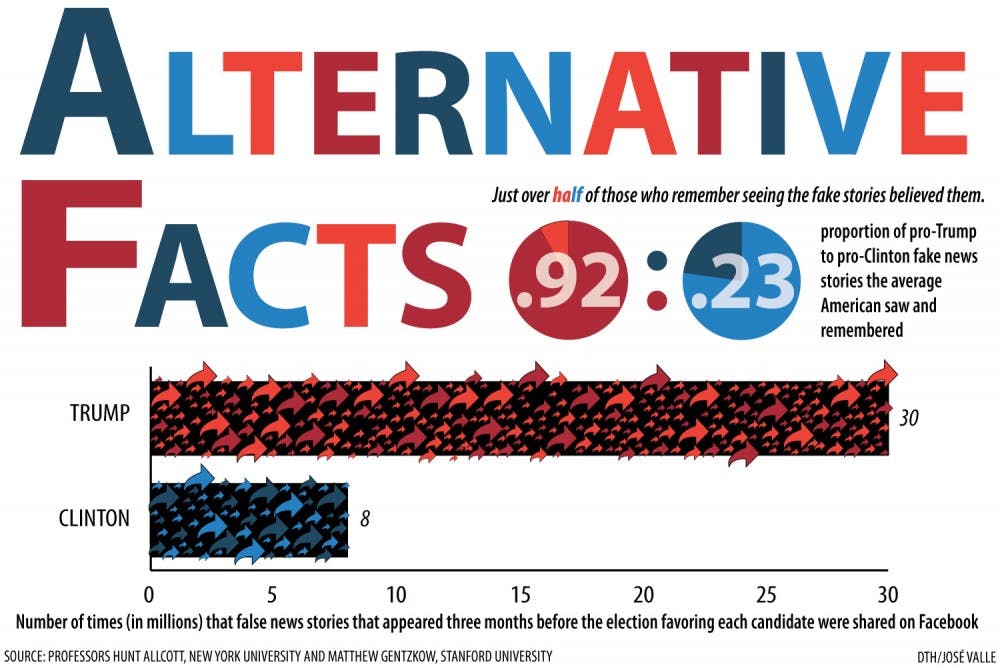“Fake news is the deliberate dissemination of a story that appears to be news but is in fact made up,” he said.
But Dallas Woodhouse, executive director of the North Carolina Republican Party, said one challenge in defining fake news is that its meaning is often inconsistent.
He said it is concerning when any one entity can decide the legitimacy of news.
“Ultimately, the consumers themselves have to do that,” he said.
Deb Aikat, a professor in the UNC School of Media and Journalism, said fake news is an increasingly misused term.
“If you look at the definition of news, news is what we want to get as reliable and truthful information,” he said. “So in calling something fake, it’s not news anymore.”
Aikat said there are four types of fake news: misinformation, conspiracy theories, clickbait and propaganda.
Entities across the political spectrum spread false information, Aikat said.
“And that kind of false information got circulated to a whole lot of people and that may have partially influenced some of the election,” he said.
Articles deliberately written to mislead are reprehensible, said Greg M, a spokesperson at NewsMutiny.com, but fake news and satire are two different mediums.
NewsMutiny.com self-identifies as “Satire for the wise. News for the dumb.”
“The limited intellectual capacity of the reader can make what others easily discern as satire and get a chuckle out of into news they’re too dumb to recognize as not real,” he said.
To get the day's news and headlines in your inbox each morning, sign up for our email newsletters.
Rick Thames, executive editor at The Charlotte Observer, said perhaps the term fake news should not be used.
“(Fake news) suggests that it’s something other than a falsehood, the deliberate misleading of people,” he said. “It’s probably better to call it what it is, which is false.”
'Alternative facts'
Comments by White House Press Secretary Sean Spicer drew controversy this week, when he said Trump’s inauguration audience was the largest to ever witness the ceremony.
Kellyanne Conway, Trump’s White House counselor, defended Spicer’s statements as “alternative facts” in an interview with CNN Sunday.
Thames said this is concerning.
“I think it’s always a concern when you believe that your federal government is not just slanting their announcements in favor of their own positions, but perhaps is also suggesting that there’s an alternative set of facts,” Thames said.
Incorrect information from the White House is not necessarily fake news, but still spreads erroneous information, Guillory said.
“But it’s also true that the podium at the White House is for the president and his aides to give their analysis, their understanding, of whatever the situation is,” he said.
He said reporters must fill the gaps and contextualize.
“And it’s the duty of reporters to report what the White House is saying, but to also put it into perspective,” Guillory said.
Tips for identification
Guillory said news articles originating from a web address that is hard to recognize should not be believable.
“The main piece of advice is to rely on reliable sources of information: major newspapers, responsible think tanks, accredited academics,” he said.
Boynton said another way to check information is to see if it is published in other reliable sources.
Some social media organizations, like Facebook, have begun to self-identify false news stories. This feature has been used for news relating to the German elections.
Consumers need to be mindful of news sources and find ones they trust, Thames said.
“We’ve never seen more need for media literacy than now,” Thames said. “People need to be savvy consumers of news and I think that that’s suddenly become all the more important.”
@crmetzler
state@dailytarheel.com




